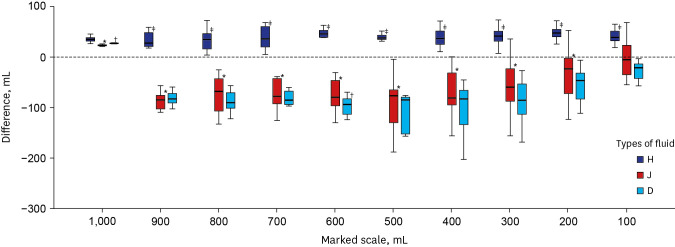J Korean Med Sci.
2022 Dec;37(49):e345. 10.3346/jkms.2022.37.e345.
Reliability of Marked Scales on Intravenous Fluid Plastic Bags
- Affiliations
-
- 1Department of Anesthesiology and Pain Medicine, Korea University Anam Hospital, Seoul, Korea
- 2Department of Anesthesiology and Pain Medicine, Changwon Hanmaeum Hospital, Changwon, Korea
- 3Korea University Ansan Hospital, Seoul, Korea
- 4Yeongjusi Health Center, Yeongju, Korea
- 5Department of Commercialization of Biomedical Technology, Viva Innovation Co., Ltd., Seoul, Korea
- 6Department of Anesthesiology and Pain Medicine, College of Medicine, Korea University, Seoul, Korea
- KMID: 2537046
- DOI: http://doi.org/10.3346/jkms.2022.37.e345
Abstract
- Precise fluid administration is important to prevent hypo- or hypervolemia. However, the accuracy of scales marked on intravenous (IV) fluid plastic bags had remained unknown. Ten 1 L sized IV crystalloids were prepared from each of three manufacturers (H, J, and D). At each scale, the actual volume of the IV fluid was measured. Differences with the measured volumes for each scale were investigated between the three manufacturers. All initial total volume was greater than 1 L. Except for the full-filled level, H overfilled, whereas J and D filled less. For J and D, the maximal differences between the scale and the measured volume were about 200 mL. Fluid volumes of each scale were significantly different among the three manufacturers (P < 0.001). It is inaccurate to measure the amount of fluid depending on the IV bag scales. Clinicians must use electronic infusion pumps for accurate fluid administration.
Keyword
Figure
Reference
-
1. Claure-Del Granado R, Mehta RL. Fluid overload in the ICU: evaluation and management. BMC Nephrol. 2016; 17(1):109. PMID: 27484681.2. Rhodes A, Evans LE, Alhazzani W, Levy MM, Antonelli M, Ferrer R, et al. Surviving sepsis campaign: international guidelines for management of sepsis and septic shock: 2016. Intensive Care Med. 2017; 43(3):304–377. PMID: 28101605.3. Favia I, Garisto C, Rossi E, Picardo S, Ricci Z. Fluid management in pediatric intensive care. Contrib Nephrol. 2010; 164:217–226. PMID: 20428006.4. McCrory RF, Gormley GJ, Maxwell AP, Dornan T. Learning to prescribe intravenous fluids: a scoping review. Perspect Med Educ. 2017; 6(6):369–379. PMID: 29119469.5. Rooker JC, Gorard DA. Errors of intravenous fluid infusion rates in medical inpatients. Clin Med (Lond). 2007; 7(5):482–485. PMID: 17990717.6. Time taping an I.V. bag: learning by example. Nursing. 2019; 49(6):1.7. Coleman WP 4th, Flynn TC, Coleman KM. When one liter does not equal 1000 milliliters: implications for the tumescent technique. Dermatol Surg. 2000; 26(11):1024–1028. PMID: 11096388.8. Byers PH, Burke EH, Overstake SK. Reading the amount of fluid in polyvinyl chloride i.v. bags. NITA. 1986; 9(6):484–487. PMID: 3642328.9. Kim JH, Wang SJ, Lee SW, Kang MS, O SH, You KC. A report for the research about the accuracy of a flow regulator. J Korean Soc Emerg Med. 2008; 19(1):109–113.10. Loner C, Acquisto NM, Lenhardt H, Sensenbach B, Purick J, Jones CM, et al. Accuracy of intravenous infusion flow regulators in the prehospital environment. Prehosp Emerg Care. 2018; 22(5):645–649. PMID: 29465284.11. Crass RE, Vance JR. In vivo accuracy of gravity-flow i.v. infusion systems. Am J Hosp Pharm. 1985; 42(2):328–331. PMID: 3976679.12. van der Eijk AC, van Rens RM, Dankelman J, Smit BJ. A literature review on flow-rate variability in neonatal IV therapy. Paediatr Anaesth. 2013; 23(1):9–21. PMID: 23057436.13. Khoyratty SI, Gajendragadkar PR, Polisetty K, Ward S, Skinner T, Gajendragadkar PR. Flow rates through intravenous access devices: an in vitro study. J Clin Anesth. 2016; 31:101–105. PMID: 27185686.14. Han PY, Coombes ID, Green B. Factors predictive of intravenous fluid administration errors in Australian surgical care wards. Qual Saf Health Care. 2005; 14(3):179–184. PMID: 15933314.
- Full Text Links
- Actions
-
Cited
- CITED
-
- Close
- Share
- Similar articles
-
- The Effects of Inline Intravenous Filtration on Bacteria, Candida and Bacterial Endotoxin Retentions
- A Study on the Item Analysis and the Reliability Evaluation of the Family Screening Test in Korea
- Effects of Aeration of Sawdust Cultivation Bags on Hyphal Growth of Lentinula edodes
- The Use of Likert Scale in Community Nutrition Research: Analysis of the Articles Published in Korean Journal of Community Nutrition
- Comparison of Equipment Contamination Level according to Enteral Nutrition Bag Cleaning and Disinfection Methods


